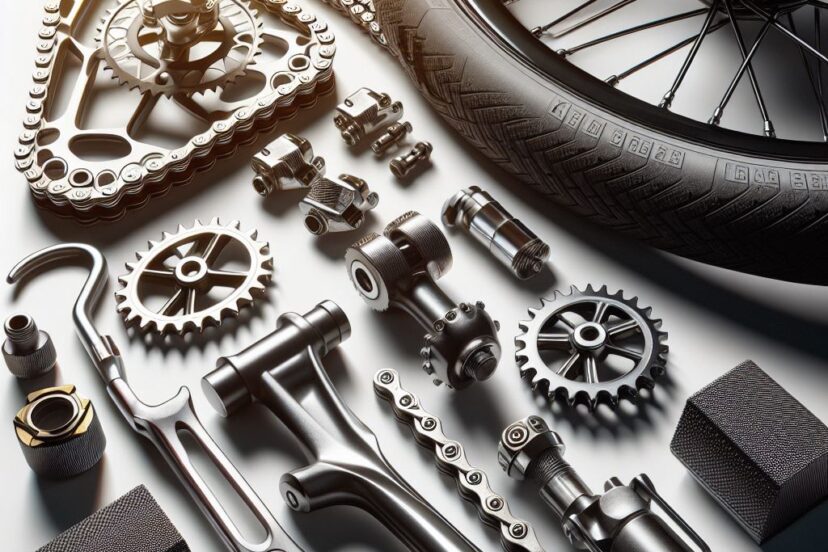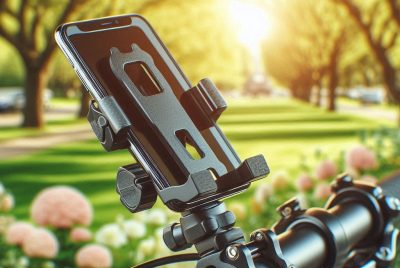BMX Bike Parts: Essential Components for Thrilling Rides
*We may earn a commission for purchases made using our links. Please see our disclosure to learn more.
BMX Bike Parts: Essential Components for Optimal Performance
When I first laid eyes on a BMX bike as a child, I was captivated by its sleek design and the fearless stunts riders performed. BMX bikes are specially designed to perform freestyle tricks, race on dirt tracks, and cruise urban environments. Each BMX bike comprises various parts that work in harmony to offer durability, agility, and performance. These bikes have customized components such as frames, wheels, handlebars, and drivetrains, which are all built to withstand the high impacts of jumping and tricks inherent in BMX riding.
The choice of BMX bike parts is critical for both the safety and performance of the bike. Sturdy frames provide the necessary support for jumps and tricks, while lightweight materials allow for greater control. The wheels, usually 20 inches in diameter, are equipped with specially designed tires that provide traction on both dirt and pavement. High-quality grip on the handlebars ensures the rider maintains control during extreme maneuvers, and the drivetrain must be robust enough to endure the rigors of BMX riding without frequent maintenance.
When selecting BMX bike parts, the material’s quality and weight are two pivotal factors. High-grade steel or aluminum ensures strength and longevity, yet each material grants differing benefits concerning weight and durability. The size and geometry of the frame also affect how the bike handles; therefore, it’s important to choose parts that align with the individual rider’s body and riding style. Additionally, performance can be enhanced by selecting bearings and wheels that roll smoothly and maintain speed.
I have dedicated countless hours to meticulous research and hands-on testing of various BMX bike components to determine which ones significantly boost the bike’s performance. Understanding the intricacies of BMX bike parts comes down to recognizing the delicate balance between strength, weight, and rider compatibility.
Top BMX Bike Parts Selection
When it comes to upgrading or maintaining a BMX bike, choosing the right components can significantly improve your ride. I’ve compiled a list of top-quality BMX bike parts that cater to both durability and performance. Whether you’re a seasoned rider or just starting out, these components are designed to enhance your BMX experience, ensuring you get the best out of every pedal.
Gashwer Brake Kit
I highly recommend this brake kit for its comprehensive set, ease of installation, and enhanced control on the road.
Pros
- Complete set for full brake overhaul
- Enhanced cable length for custom setups
- Straightforward installation process
Cons
- Provided tools may lack durability
- Cable lengths could be excessive for smaller bikes
- No installation instructions included
I recently had the chance to fit the Gashwer Brake Kit on an old BMX that needed serious brake work. The package had all the pieces necessary for both the front and rear brakes, which saved me the hassle of purchasing additional parts. Thanks to the extended cables, I customized the setup for optimal performance, a feature particularly beneficial for riders who might have unique rigging requirements.
The inclusion of multi-tools and wrenches was a convenient touch, but the quality didn’t match up to my professional-grade tools. For a one-off installation, they’re adequate, but for more frequent use, sturdier tools may be required. Despite these tools, the absence of explicit instructions meant a little improvisation was needed. Thankfully, my experience with bike mechanics filled this gap, but for novices, a quick online tutorial might be necessary.
Handling and responsiveness noticeably improved following the installation. Adjusting the spring tension on the brake arms allowed for fine-tuning, which took a bit of trial and error but was ultimately straightforward and rewarding. The Gashwer Brake Kit is undeniably a great choice for someone looking to upgrade their BMX or mountain bike’s braking system. With a bit of patience for setup, the results will speak for themselves.
Acxico Freewheel Sprocket
If you’re in the market for a durable and straightforward BMX part, the Acxico Freewheel Sprocket is a solid choice that won’t disappoint.
Pros
- Robust steel construction ensures longevity
- Simple single speed design for easy maintenance
- Compatible with 1/2″ x 1/8″ bike chains
Cons
- Limited to 14 teeth, which may not suit all riders
- Installation might require additional spacers
- Color portrayal online may differ from actual product
After recently fitting the Acxico Freewheel Sprocket onto my BMX, I noticed an immediate improvement in the bike’s performance. The installation process was a breeze, which for me, is a significant plus. Its steel build feels sturdy, giving me confidence in the durability of this part. Riding felt smoother, and the transition between speeds seemed more reliable compared to my old freewheel.
Over the past few weeks of using this sprocket, I’ve put it through its paces at the local skatepark. The 14 teeth provide sufficient speed for street riding, though some riders might prefer a different size for ramp work or racing. However, its standard fit seems universally compatible with most chains I’ve dealt with, making it a go-to replacement part.
While the difference in color from the online image was initially a surprise, it proved to be a minor issue as the performance was unaffected. I did have to add some spacers for a perfect fit, but once installed, the sprocket has held up well without any issues. The Acxico Freewheel Sprocket has proven to be a reliable component of my BMX setup, and I’d recommend it to other riders looking for a fuss-free upgrade or replacement.
Boruizhen Pedals
I recently took these pedals for a spin, and I can confidently say they’re a solid choice for anyone looking to upgrade their BMX or MTB.
Pros
- Exceptionally grippy with 16 anti-skid nails
- Remarkably lightweight, enhancing bike handling
- Durable aluminum build that can endure regular use
Cons
- White color may show dirt and scratches easily
- Might feel too large for those who prefer smaller platforms
- Bearings may require additional lubrication out-of-the-box
The immediate impression these pedals give off is the confidence you feel with each push. The 16 anti-skid nails really do their job, making each pedal stroke effective and safe, even in wet conditions. It’s just the right amount of traction without feeling stuck.
Another aspect I appreciated was how light they felt. When racing or pulling off tricks, the last thing you want is heavy pedals weighing you down. These Boruizhen pedals felt almost unnoticeable, allowing me to maneuver with ease and reducing the burden on my legs during long rides.
Durability is also a big win. Aluminum is known for its strength-to-weight ratio, and it shows here. I’ve put these pedals through the paces on rugged trails and city streets alike, and they’ve withstood the abuse without any noticeable wear.
One minor nigget is the white finish. It looks sleek out of the box, but it’s not the most forgiving color when it comes to dirt and scuffs. If you’re someone who likes to keep their ride looking pristine, you might find yourself cleaning these pedals often.
Additionally, the platform size could be a matter of personal preference. Riders who are used to more compact pedals might find these a bit large, but I found the ample foot space translated to better control and comfort, especially over longer distances.
Lastly, fresh out of the package, the bearings felt a bit stiff. A quick application of lubricant smoothed things out, but it’s something to be aware of if you prefer components that are perfect from the get-go.
In summary, the Boruizhen pedals are a high-performance addition to any BMX or MTB, packing both punch and endurance into a lightweight package.
ODI Longneck BMX Grips
As a BMX enthusiast, I believe these ODI grips offer a great combination of comfort and durability that would benefit any rider’s setup.
Pros
- Exceptional grip and hand comfort
- Straightforward installation process
- Robust construction ensuring long-term use
Cons
- May require trimming for certain handlebars
- Installation might need additional tools like alcohol or an air compressor
- Some riders might prefer a softer compound
After trying out the ODI Longneck BMX Grips on my latest ride, I was impressed by how well they performed. The grip texture provided excellent hand traction, which made a noticeable difference in control when performing tricks and jumps. The black color also gave my BMX a sleek, professional look.
The installation process was easier than expected. A bit of rubbing alcohol facilitated sliding them onto my handlebars smoothly. The grips stayed in place without twisting or slipping, even after several hours of intense riding.
Despite these positives, I did note that the grips were slightly longer than my previous ones. I had to shorten them with a razor blade, but this modification was easily done and didn’t impact performance. Also, some beginners might be unaware that installation is best done with tools like rubbing alcohol or an air compressor to ease the grips on.
In conclusion, the ODI Longneck BMX Grips are reliable and add considerable value to a BMX. They offer a solid grasp, ease of installation, and durability that’s hard to beat at this price point. Be mindful of the potential need for slight modifications on certain bike models, but overall, these grips are a quality investment for both casual riders and serious BMX enthusiasts.
Saipe BMX Chain Tensioners
These Saipe Chain Tensioners will be a solid addition to your BMX toolkit, offering a no-fuss chain tensioning solution with a striking aesthetic.
Pros
- Enhances chain tension reliability and simplicity
- Vibrant color adds a custom touch to your bike
- Straightforward, tool-free installation
Cons
- May require additional spacers for some BMX frames
- Potential alignment issues noted by a few users
- Long-term durability of color finish is uncertain
Having recently fitted these Saipe Chain Tensioners to my single-speed, I noticed an immediate improvement. The convenience they offer is undeniable. Without the need for any cumbersome tools, I adjusted chain tension with ease – and just like that, my days of annoying chain slack were over.
The burst of red from these tensioners added a custom flair to my BMX. It’s not often that a practical upgrade doubles as a style enhancement, but in this case, it did. The anodized finish caught the sunlight in just the right way, turning a few heads at the park.
However, it’s worth mentioning that getting them aligned perfectly took a bit more effort than expected. I’d read about potential alignment issues, and while it wasn’t a deal-breaker, I had to be a little meticulous. For BMX riders considering these tensioners, remember they may not be a perfect fit for all frame sizes; some additional spacers could be needed.
In summary, the Saipe Chain Tensioners are a straightforward, stylish, and practical choice for any BMX enthusiast looking to streamline their single-speed setup. But be prepared to possibly tweak them a bit for optimal performance.
BMX Bike Parts – Buying Guide
When selecting BMX bike parts, I consider several key features to ensure I get the best component for my needs. The parts need to match my riding style, compatibility with my bike, quality of materials, and budget.
Compatibility
I first check the component’s compatibility with my existing bike setup. The specifications such as size, model, and type are crucial. For example:
- Wheel Size: Matching my bike’s frame.
- Brake Type: Compatibility with my wheel’s braking surface.
- Crank Length: Appropriate for my leg length and riding style.
BMX Bike Parts: Material and Build Quality
The durability and weight of the BMX parts are influenced by their material:
| Material | Benefit |
| Steel | Durable, often heavier |
| Aluminum | Lighter, less durable than steel |
| Carbon | Lightweight, expensive |
| Titanium | Strong and light, very costly |
Strength is essential, so I ensure the parts are built to withstand the rigors of BMX riding.
Rider Style
My choice of parts also depends on my riding style:
- Street: Sturdy, impact-resistant parts.
- Park: Light parts for aerial tricks.
- Dirt: Traction-focused tires and strong wheels.
Price and Quality Balance
Affordability is key, but I don’t compromise on quality. Premium materials usually come at a higher cost, yet investing in durable parts can save money long-term.
By thoughtfully considering these aspects, I equip my BMX with parts that can enhance my riding experience without unnecessary expenses.
FAQs About Your BMX Bike Parts
In this section, I’ll answer some of the most common inquiries regarding BMX bike parts, focusing on what’s essential for assembling, riding, and maintaining your BMX bike.
1. What components are needed to assemble a complete BMX bike?
To assemble a complete BMX bike, you’ll need a frame, fork, handlebars, grips, stem, headset, gear crank, bottom bracket, chain, pedals, wheels (including rims, hubs, spokes), tires, a seat, seat post, and brakes.
2. Which part of a BMX bike is considered the most crucial for performance?
The frame of a BMX bike is the most crucial for overall performance as it impacts durability, weight, and riding style. A well-designed frame can greatly influence how the bike handles and responds to tricks and jumps.
3. At what age is it appropriate to ride a 20 inch BMX bike?
It is typically appropriate for individuals around the age of 7 and older to ride a 20-inch BMX bike. However, overall fit and skill level should be considered, and it is always advisable to test for comfort.
4. Is it more challenging to ride a BMX bike compared to other bicycles?
Riding a BMX bike can be more challenging due to its smaller size, responsive handling, and design intended for stunts and racing. It requires a different set of skills compared to riding other bicycles.
5. How do you properly maintain and care for BMX bike parts?
Proper maintenance for BMX bike parts includes regular cleaning, lubrication of moving parts like the chain and bearings, checking tire pressure, and ensuring that all bolts and fasteners are properly tightened.









